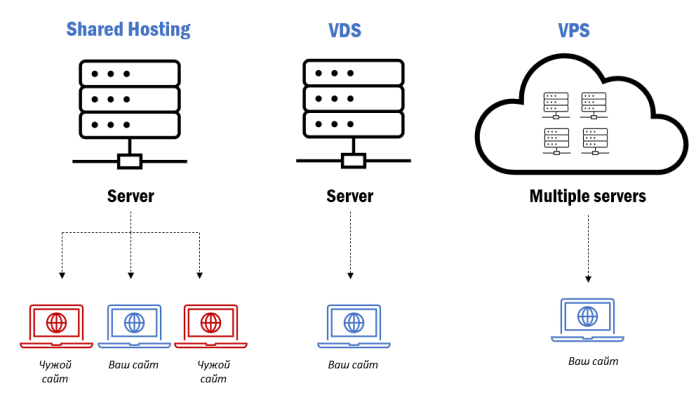VPS (virtual private server). Assumes the use of virtualization technology implemented at the software level. For example, Virtuozzo or OpenVZ. It is distinguished by comparative simplicity of management and flexible settings. VDS (virtual dedicated server). For virtualization hardware is used, for example, KVM.

With this virtualization technology you get a specific amount of server resources regardless of the intensity of its use. This allows you to install or reinstall software yourself, including OS, unlike a VPS server.
Comparison of VPS and VDS
For example, you can compare the capabilities of VPS and VDS, which use virtualization methods KVM, OpenVZ.
|
Criterion |
virtual server |
|
|
VDS |
VPS |
|
|
Virtualization method |
Hardware |
Software |
|
Compatible OS |
Windows, Ubuntu, FreeBSD, Debian, Centos |
Debian, Centos, Ubuntu |
|
Operating system kernel |
Present |
No |
|
Install your own OS |
Allowed |
No |
|
Degree of isolation from other virtual servers |
Full |
Partial |
|
Changing parameters, changing tariff plan |
Via reboot |
Effective without reboot |
|
Ability to use remote desktop |
Yes (RDP) |
No |
|
Ability to install VPN |
Yes |
Yes |
|
Possibility to connect via VPN |
Yes |
No |
|
Connection using SSH |
Yes |
Yes |
The difference between VDS and VPS is the degree of isolation. VPS works together with other similar virtual servers on a common physical server. Under them is allocated a common pool of resources: disk space, RAM, CPU time. In fact, it functions with a limited level of independence.
VDS also has its own dedicated resources, however, they are characterized by a clearer designation. Not CPU time, but its own processor core, a separate disk array and a strictly designated amount of RAM, which is not reduced regardless of workload. Such technology provides for a deepening degree of isolation, the ability to more predictably and fully utilize the allocated resources.
Virtual hosting
Unlike VDS and VPS virtual hosting has a number of disadvantages. First of all, the amount of resources provided is much lower and can vary depending on the load. The ability to customize the existing software, including or server and installation of new software is significantly limited. The range of tasks that can perform virtual hosting is much smaller.
In fact, it is only the placement of sites with a certain number of settings. In contrast to Virtual Server, which can be the base for setting up VPN distribution, placing large amounts of databases, installation and use of various bots, installation of the server part of network games.
Physical hosting
On the principle of operation of the rental of physical hosting / server is similar to VDS Virtual Server. Only in the first case, the user is provided with the entire server with all its resources. The absence of "neighbors" on the physical machine gives extremely wide management possibilities. The user can independently install, remove software, split, add disks, overload or completely shut down the server.
However, your hosting has one significant disadvantage - the cost of rent is several times higher than VDS. While their functionality is almost identical. And some additional features do not have a critical negative impact on the functionality of sites.
Advantages of VDS/VPS

Virtual server gives the following advantages:
- Large and clearly defined amount of resources, allowing you to place several sites on one VPS server
- Data protection (SSH), dedicated ip-address, as well as the ability to install other application programs.
- Quickly switch to another tariff with an increase, decrease in performance and respectively increase, decrease in cost.
- The user is given administrator access, which allows you to customize the software, both the site and the server itself.
- Ability to choose a control panel that facilitates work with the virtual server. For example, VestaCP or Cpanel.
The use of VDS/VPS is justified in the following cases:
- Installation of specialized software is required to maintain the site.
- The site lacks the resources provided by conventional shared hosting.
- The specifics of the project requires the provision of a large amount of RAM, disk memory or CPU.
- Resources are needed to implement mailing lists.
What to choose?
Having assessed the practical usefulness of VPS and VDS We can come to the conclusion that the first option of virtual server provides more opportunities, both in terms of resources and reliability, which is almost the same as renting a physical server.
VPS distributes the resources of the physical server between all tenants, which in the case of overload can significantly reduce performance and even lead to the stoppage of the site. However, this option is much cheaper.
After comparing the possibilities, we can conclude that VDS is better to use for large projects with high resource requirements, and VPS is advisable to rent for small sites.